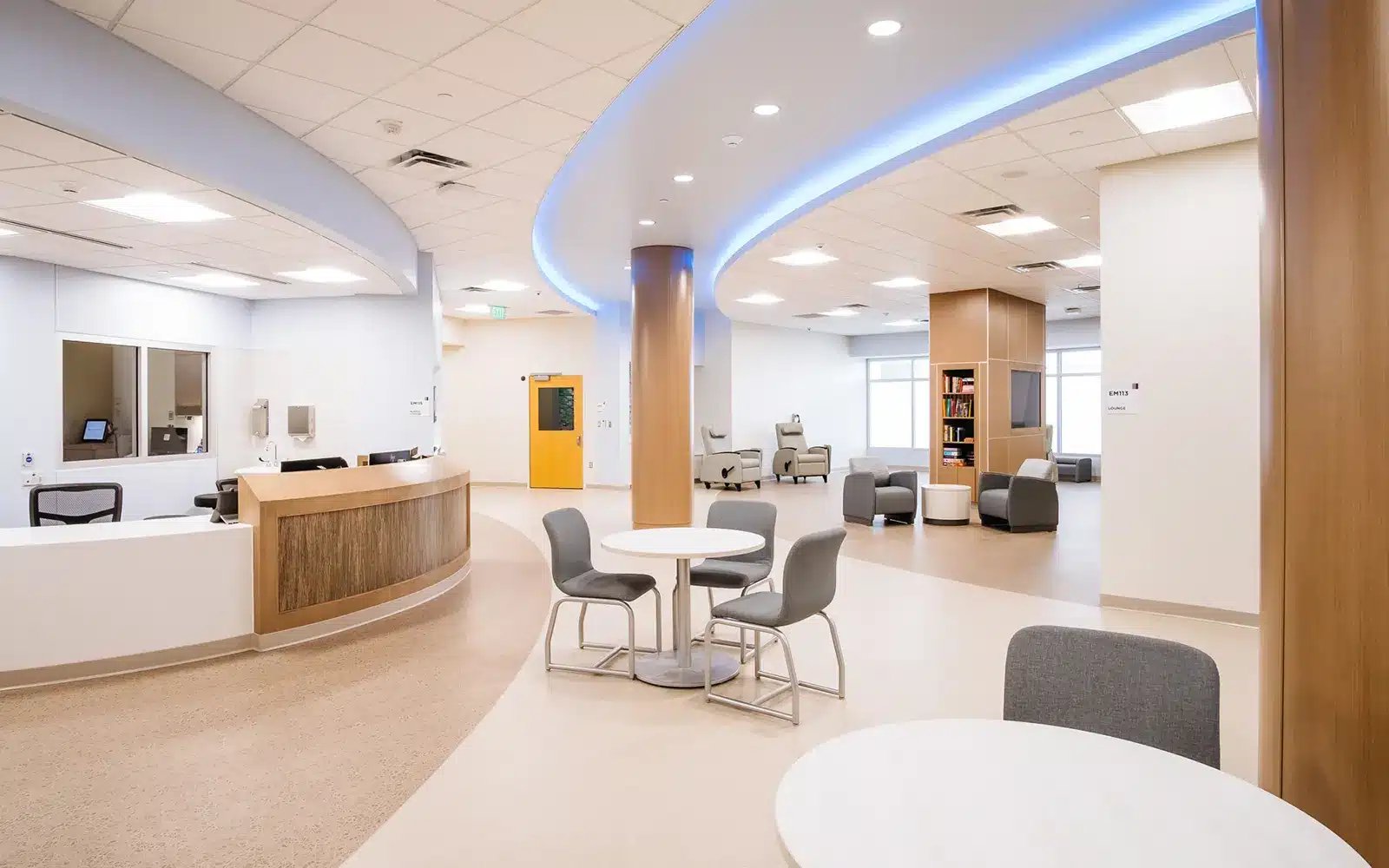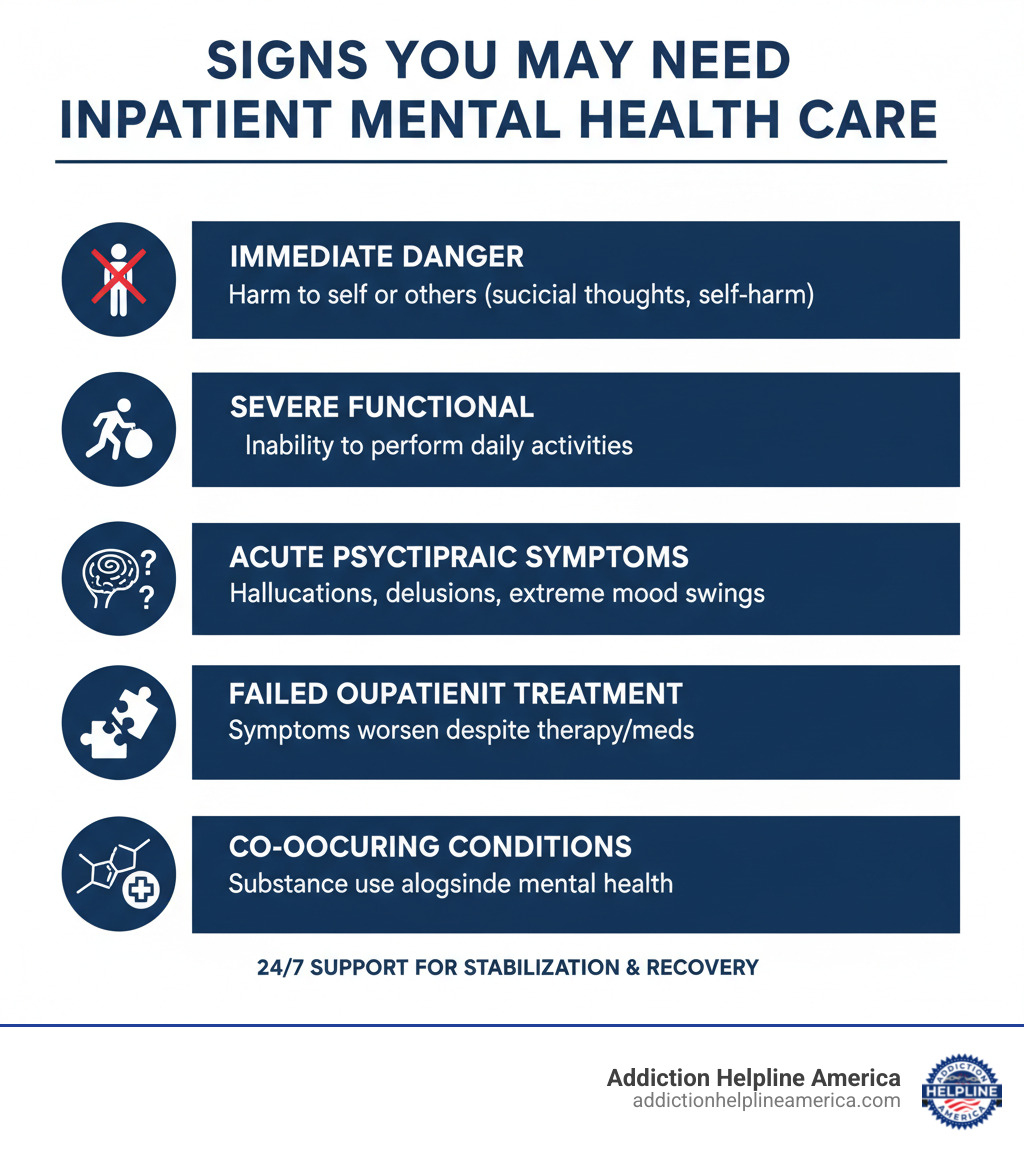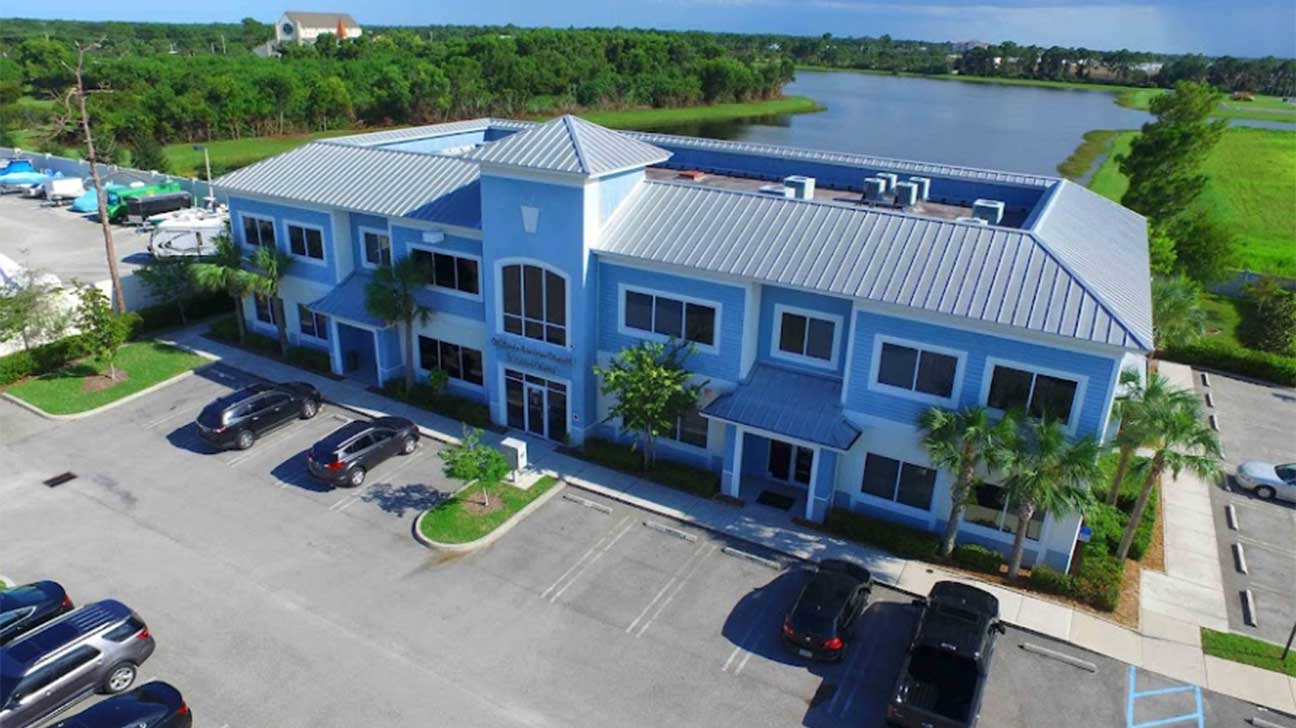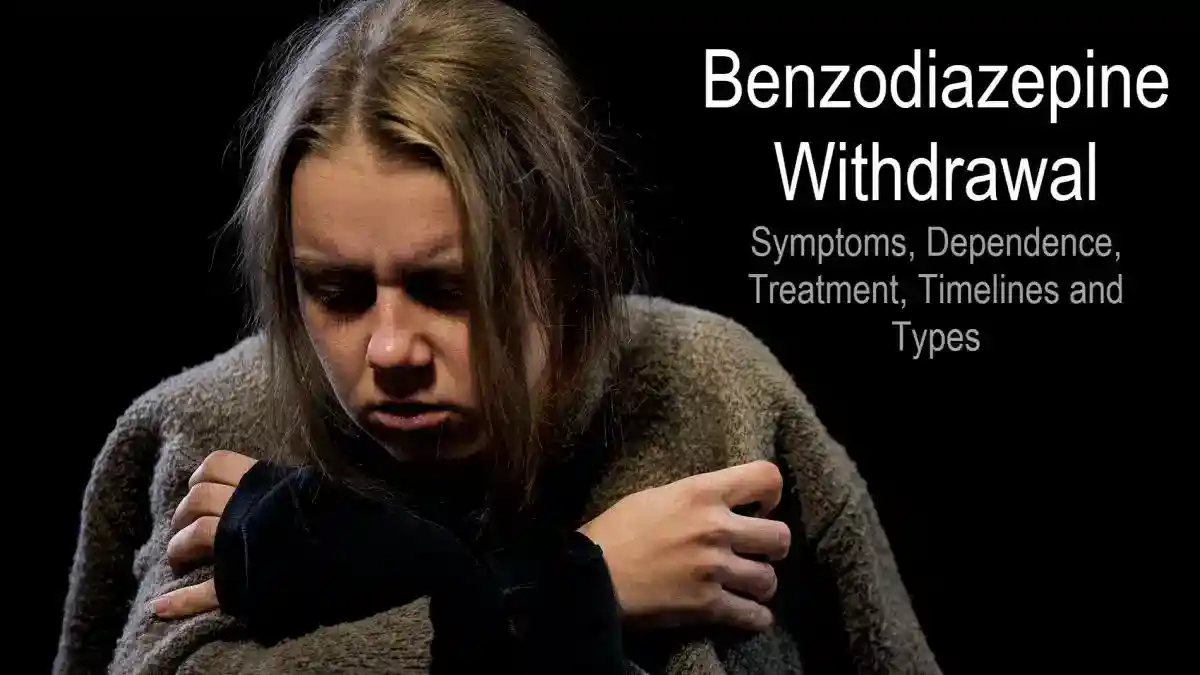
Understanding Inpatient Mental Health: A Lifeline in Crisis
Inpatient mental health care offers 24/7 medical supervision and intensive treatment for severe psychiatric crises. When symptoms can no longer be safely managed at home, these programs provide a protected environment focused on stabilization and recovery.
Inpatient care may be necessary if an individual is an immediate danger to themselves or others, experiences severe functional impairment, or has acute symptoms like psychosis or extreme mood swings. While most people with mental illness never need hospitalization, it can be a lifesaving intervention when a crisis becomes overwhelming.
The goal is not just to manage the crisis but to equip you with coping skills and a clear path forward. A typical stay, which averages 11-13 days, involves assessment, personalized treatment planning, daily therapy, medication management, and discharge planning from day one.
At Addiction Helpline America, we guide individuals and families through finding the right inpatient mental health care. We know this step can be difficult, but it is often the turning point toward lasting recovery.

Basic inpatient mental health vocab:
Understanding Acute Inpatient Care: When and What to Expect
When mental health symptoms become a crisis, acute inpatient mental health care is a critical lifeline. This level of care is for moments of severe psychiatric distress—when someone poses an imminent danger to themselves or others, or when symptoms make basic self-care impossible. These specialized units, found in hospitals or freestanding psychiatric facilities, provide 24/7 monitoring and intensive treatment focused on one goal: stabilization.

What to Expect from an Inpatient Mental Health Admission
The admission process begins with a thorough initial assessment to understand your symptoms and needs. This helps determine if inpatient care is the right fit. Admission can be voluntary, where you consent to treatment, or involuntary if a person is a danger to themselves or others and cannot recognize their need for help. Before admission, the facility will handle insurance verification to clarify coverage and costs. Addiction Helpline America can help you steer this process.
When packing, bring comfortable clothing (without strings), basic hygiene items (non-aerosol), and a list of your medications. Leave sharp objects, belts, shoelaces, and most electronics at home to ensure a safe environment for everyone.
Types of Inpatient Psychiatric Facilities
Not all inpatient mental health facilities are the same. Options include:
- General hospital psychiatric units: Best for acute crises, especially with co-occurring medical conditions.
- Stand-alone psychiatric hospitals: Focus exclusively on mental health and may offer broader therapeutic programs.
- State-run facilities: Often provide longer-term care for individuals with severe and persistent mental illnesses.
- Private facilities: Tend to be smaller, offering more personalized attention and amenities.
- Specialized units: Provide age-appropriate care for children, adolescents, or older adults.
Find a treatment facility near you
A Typical Day and Length of Stay
Life in an inpatient mental health facility is structured to support healing. A typical day includes:
- Group therapy sessions on topics like coping skills and emotional regulation.
- Individual counseling to explore personal issues.
- Medication management with medical staff.
- Recreational activities like art or yoga.
- Educational workshops about your condition.
The length of stay varies based on individual needs, though the average is 11-13 days. The goal is to ensure you are stable and equipped with the tools you need before transitioning to the next phase of recovery. Addiction Helpline America is here to help you take these first steps.
Therapies, Treatments, and the Care Team
In an inpatient mental health facility, you gain access to a multidisciplinary team and evidence-based therapies custom to your needs. The focus is on treating the whole person to support a lasting recovery.

Core Therapies and Interventions
Treatment is built on practical, proven therapies that provide tools for recovery.
- Cognitive Behavioral Therapy (CBT) helps you identify and change negative thought patterns and behaviors.
- Dialectical Behavior Therapy (DBT) teaches skills in mindfulness, distress tolerance, and emotion regulation.
- Psychotherapy (talk therapy) provides space to explore deeper issues in one-on-one sessions.
- Medication management is overseen by a psychiatrist who prescribes and monitors medications to stabilize symptoms.
- Family and group therapy offer support by improving communication and reducing isolation.
Other approaches like trauma-focused therapies (e.g., EMDR), art therapy, and mindfulness may also be part of your treatment plan. Addiction Helpline America connects you with facilities offering these evidence-based therapies. Explore more about evidence-based therapies.
The Role of the Interdisciplinary Team
Your care is a collaborative effort. Your team will include:
- Psychiatrists who diagnose, prescribe medication, and oversee your medical treatment.
- Psychologists and therapists who provide individual and group counseling.
- Nurses who offer 24/7 monitoring, administer medication, and provide support.
- Social workers who handle discharge planning and connect you to community resources.
- Other specialists like occupational, recreational, and peer support therapists who help you rebuild daily living skills and offer hope through lived experience.
Aftercare and Discharge Planning
Discharge planning begins on day one to ensure a smooth transition back to your life. A comprehensive aftercare plan is crucial for preventing relapse and supporting long-term recovery.
Key components include:
- Step-down programs like Partial Hospitalization (PHP) or Intensive Outpatient (IOP) to provide continued, structured support.
- Community connections to local therapists, support groups, and other resources.
- Follow-up appointments with your outpatient care team.
- A relapse prevention plan that identifies triggers and coping strategies.
Effective aftercare significantly improves the chances of maintaining recovery. Addiction Helpline America can help you access the ongoing care you need. Learn more about aftercare and relapse prevention resources.
Rights, Legalities, and Family Involvement in Inpatient Mental Health
When you or someone you love enters inpatient mental health care, you’re not leaving your rights at the door. Understanding what protections you have, how the law works in these situations, and how your family can be involvedthese aren’t just legal details. They’re essential parts of feeling safe, respected, and supported during one of life’s most vulnerable moments.

Patient Rights and Consent
Every person receiving inpatient mental health care has fundamental rights that protect their dignity and autonomy. These include the right to privacy, the right to be informed about your treatment, and the right to participate in care decisions. You generally have the right to refuse treatment, though this can be complex during an involuntary admission.
Involuntary admission is reserved for acute crises where a person is an imminent danger to themselves or others and is unable to recognize their need for care. Even in these cases, legal safeguards are in place to protect patient autonomy as much as possible. To learn more about your specific protections, you can consult resources from organizations like the National Alliance on Mental Illness (NAMI) and the Substance Abuse and Mental Health Services Administration (SAMHSA).
Seclusion, Restraint, and Safety Policies
Restraint and seclusion are last resorts, used only when someone is at immediate risk of harming themselves or others, and every other approach has failed. Modern inpatient mental health facilities prioritize trauma-informed care and train staff in de-escalation techniques to avoid these interventions whenever possible. The goal is always to create a safe, respectful environment where crises can be managed therapeutically.
The Role of Family and Wh1nau
Recovery doesn’t happen in isolation. Your family and chosen support people are vital partners in your healing journey. With your permission, they can participate in shared decision-making, stay informed about your progress, and learn how to best support you. Most facilities have visiting policies and may offer family therapy or support groups. Research shows that when families are involved in inpatient mental health care, outcomes improve.
At Addiction Helpline America, we work with families just as much as we work with individuals seeking treatment. We can help you understand what to expect and how to be involved through our family involvement resources.
Advancing Equity and Quality in Modern Care
The heart of modern inpatient mental health care beats with a simple promise: every person deserves treatment that sees them, understands them, and meets them exactly where they are. This means addressing systemic gaps and personalizing care to support all paths to healing.
Special Considerations for Inpatient Mental Health Care
Personalized care means adapting treatment to fit the individual. For people with autism or learning disabilities, this may involve creating sensory-friendly spaces and using visual communication aids. For those with co-occurring substance use disorders, integrated treatment that addresses both mental health and addiction simultaneously is essential for success. For LGBTQ+ individuals, inclusive care—from using correct pronouns to providing staff training—creates a safe environment necessary for healing.
| Feature | Standard Inpatient Care | Adapted Inpatient Care for Specific Needs (e.g., Autism, Learning Disability) |
|---|---|---|
| Environment | General ward layout, standard lighting | Low sensory areas, quiet rooms, dimmer switches, reduced fluorescent lighting |
| Communication | Verbal, written information | Visual aids, simple language, Augmentative and Alternative Communication (AAC), independent advocates |
| Routine | Flexible, may change daily | Predictable schedules, clear visual timetables, preparation for changes |
| Engagement | Group activities, general interventions | Individualized activities, special interests, sensory input preferences |
| Staff Training | General mental health training | Specialized training in autism awareness, learning disabilities, communication |
| Personal Items | Limited personal items | Encouragement of comfort items, visual schedules for personal belongings |

Addressing Health Inequalities
Quality care must be equitable. For racialized and ethnic minority communities, this means providing culturally competent services, offering professional interpreters, and building trust. A trauma-informed approach is foundational for all patients, recognizing that past trauma can influence current behavior and requires a focus on safety and trust. By honestly examining who is underserved, we can identify and address the inequalities that persist in mental healthcare.
The Future of Inpatient Services
The future of inpatient mental health care focuses on providing the right care at the right time. This involves workforce development to build skilled, diverse teams and integrating technology to improve continuity of care. Stronger collaboration with community services ensures seamless transitions from the hospital back to daily life. The goal is to make every hospital stay as brief and therapeutic as possible, using innovations that place the individual at the center of their own recovery.
At Addiction Helpline America, we track these developments closely, connecting you with facilities that embody this vision of compassionate, effective, and equitable care.
Frequently Asked Questions about Inpatient Mental Health
Can I be admitted against my will?
Yes, but only under strict legal circumstances. Involuntary commitment is an emergency measure used when a person is an imminent danger to themselves or others, or is so gravely disabled they cannot care for themselves. This process involves legal review and safeguards to protect your rights. The goal is always stabilization and safety, not punishment.
What can I bring with me to the hospital?
Packing for an inpatient mental health stay requires following safety guidelines.
- What to Bring: Several days’ worth of comfortable clothing (without drawstrings), slip-on shoes, personal hygiene items (non-aerosol and alcohol-free), a list of your medications, and your ID/insurance cards.
- What to Leave at Home: Sharp objects (razors, scissors), belts, shoelaces, glass containers, alcohol, illegal substances, and electronics like phones and laptops. These rules create a safe environment for everyone.
How much does inpatient mental health care cost?
The cost of inpatient mental health care varies widely, but several options can help manage it. Insurance coverage through private plans, Medicare, or Medicaid is the most common way to pay. Most facilities also accept private pay and may offer payment plans. State-funded programs and financial assistance are also available for those who qualify.
Navigating costs and benefits can be confusing. The team at Addiction Helpline America provides free, confidential guidance to help you understand your options and find a program that fits your clinical and financial needs. You don’t have to figure this out alone.
Conclusion
Taking the step toward inpatient mental health care can feel overwhelming, but it’s often the most important decision someone can make when facing a severe psychiatric crisis. Throughout this guide, we’ve walked through what inpatient mental health treatment really looks like—from the initial assessment and admission process to the structured days filled with therapy, the dedicated professionals who make up your care team, and the thoughtful discharge planning that begins from day one.
The path to recovery isn’t always straight or easy, but inpatient mental health care provides a safe harbor during life’s most difficult storms. It’s where you can rest, receive professional help, and begin building the skills and confidence you need to move forward. This isn’t just about managing a crisis—it’s about finding hope and finding that recovery is possible.
At Addiction Helpline America, we’ve helped thousands of people across the country—from Alabama to California, from Florida to New York—find the right treatment center for their unique situation. We offer free, confidential guidance because we believe that everyone deserves access to quality mental health care, and no one should have to figure this out alone. Whether you’re calling for yourself or a loved one, our compassionate team is here to listen, answer your questions, and connect you with facilities that truly fit your needs.
Your journey to stabilization and recovery starts with that first brave step. You don’t have to take it alone.
Our helpline is 100%
free & confidential
If you or someone you care about is struggling with drug or alcohol addiction, we can help you explore your recovery options. Don’t face this challenge alone—seek support from us.
Programs
Resources
Will my insurance
cover addiction
treatment?
We're ready to help
Find the best
drug or alcohol treatment
center
Are you or a loved one struggling with addiction? Call today to speak to a treatment expert.












